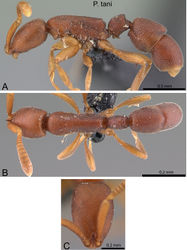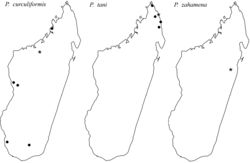Probolomyrmex tani\according to Hita Garcia et al 2014
| Notice: | This page is derived from the original publication listed below, whose author(s) should always be credited. Further contributors may edit and improve the content of this page and, consequently, need to be credited as well (see page history). Any assessment of factual correctness requires a careful review of the original article as well as of subsequent contributions.
If you are uncertain whether your planned contribution is correct or not, we suggest that you use the associated discussion page instead of editing the page directly. This page should be cited as follows (rationale):
Citation formats to copy and paste
BibTeX: @article{Hita2014DeutscheEntomologischeZeitschrift61, RIS/ Endnote: TY - JOUR Wikipedia/ Citizendium: <ref name="Hita2014Deutsche Entomologische Zeitschrift61">{{Citation See also the citation download page at the journal. |
Ordo: Hymenoptera
Familia: Formicidae
Genus: Probolomyrmex
Name
Probolomyrmex tani Fisher, 2007 – Wikispecies link – Pensoft Profile
- Probolomyrmex tani Fisher 2007[1]: 146.
Type material
Holotype, pinned worker, MADAGASCAR, Antsiranana, Forêt d’Analabe, 30.0 km 72° ENE Daraina, 13.08333°S, 49.90833°E, 30 m, littoral rainforest, collection code BLF9426, 27.XI.2003 (B.L. Fisher et al.) (CASC: CASENT0041505). Paratypes, one pinned worker (CASC: CASENT0041507) and one dealate queen (CASC: CASENT0041506) with same data as holotype.
Non-type material
MADAGASCAR: Antsiranana, Ambondrobe, 41.1 km 175° Vohemar, 13.71533°S, 50.10167°E, 10 m, littoral rainforest, 29.XI.2004 (B.L. Fisher) (CASC: CASENT0056575; CASENT0057032); Antsiranana, Forêt de Binara, 9.4 km 235° SW Daraina, 13.26333°S, 49.6°E, 1100 m, montane rainforest, 5.XII.2003 (B.L. Fisher) (CASC: CASENT0043467; CASENT0043468; CASENT0043471); Antsiranana, Montagne des Français, 7.2 km 142° SE Antsiranana, 12.32278°S, 49.33817°E, 180 m, tropical dry forest, 22.–28.II.2001 (B.L. Fisher et al.) (CASC: CASENT0004400); Antsiranana, Makirovana forest, 14.16666°S, 49.95°E, 715 m, rainforest, 1.–2.V.2011 (B.L. Fisher et al.) (CASC: CASENT0243171; CASENT0243185); Antsiranana, Makirovana forest, 14.17066°S, 49.95409°E, 225 m, rainforest, 4.–6.V.2011 (B.L. Fisher et al.) (CASC: CASENT0231492).
Diagnosis
The following character set distinguishes Probolomyrmex tani from its congeners in Madagascar: head in full-face view between 1.5 to 1.6 times longer than broad (CI 64–66); SI 92–103; in profile mesosomal outline flat to very weakly convex, metanotal groove usually absent, but rarely weakly developed; hind tibia around 1.0 to 1.1 times longer than head width (HTLI 100–111); petiole relatively longer, lower, and less arched, in profile (without ventral process) around 1.3 to 1.5 times longer than high (LPNeI 127–150), and in dorsal view around 1.4 to 1.6 times longer than broad (DPeI 63–69).
Worker measurements
(N=10). HL 0.56–0.65 (0.60); HW 0.37–0.42 (0.39); SL 35–43 (0.39); WL 0.73–0.91 (0.80); PH 0.25–0.30 (0.27); PW 0.27–0.35 (0.30); HTL 0.39–0.47 (0.42); PeH 0.26–0.31 (0.28); PeNH 0.19 –0.23 (0.21); PeNL 0.26–0.34 (0.29); PeW 0.17–0.22 (0.19); CI 64–66 (65); SI 92–103 (0.98); LMI 33–37 (35); HTLI 100–111 (104); DPeI 63–69 (67); LPeI 97–110 (103); LPeNI 127–150 (137); PeNI 60–66 (63).
Worker description
In full-face view head between 1.5 to 1.6 times longer than broad (CI 64–66), posterior head margin flat or weakly concave; lateral margins of head convex, broadest medially, posterolateral corners rounded; clypeus and anterior part of frons strongly protruding anteriorly as narrow frontoclypeal, subrectangular shelf or socket; antennal sockets exposed and closely approximated, separated by a thin, vertical lamella formed by fused frontal carinae; mandibles small, triangular to elongate-triangular, masticatory margin armed with one larger apical tooth and a series of six smaller denticles, in full-face view mandibles obscured by frontoclypeal shelf; palp formula 4,2; eyes absent; antennae 12-segmented, funicular antenommeres growing in size and width towards apex without forming well defined antennal club, apical antennomere much larger than remaining funicular antenommeres, antennal scape short (SI 92–103), far from reaching posterior head margin. Mesosoma slender, long, and relatively low (LMI 33–37), in profile mesosomal outline flat to very weakly convex; propleurae enlarged and projecting ventrally; promesonotal suture absent; metanotal groove usually absent, rarely present but very weak; declivitous face of propodeum margined by low, obtuse, and concave lamella on each side, propodeal lamella posterodorsally with small, blunt tooth, posteroventrally with rounded lobe or very blunt tooth; posterior declivity of propodeum weakly concave in dorsal view. Legs long and slender; all tibiae with single, pectinate spur; pretarsal claws simple without median tooth; hind tibia around 1.0 to 1.1 times longer than head width (HTLI 100–111). In profile petiole with subpetiolar process around 1.0 to 1.1 times longer than high (LPeI 97–110), petiole without subpetiolar process around 1.3 to 1.5 times longer than high (LPNeI 127–150), petiolar dorsum strongly arched, much higher posteriorly, anterior face curving smoothly onto dorsum without well developed anterodorsal margin, posterior face vertical and concave, enclosed laterally and dorsally by low, thick carina; in dorsal view petiole around 1.4 to 1.6 times longer than broad (DPeI 63–69); pronotum between 1.5 to 1.7 times longer than petiolar width (PeNI 60–66); subpetiolar process well developed and lamelliform, ventral face weakly concave, anteroventral portion rounded to moderately angled, posteroventral portion sharper and stronger angled, projecting backwards, variably developed, ranging from right angle to a elongate-triangular tooth. Abdominal segment III in profile narrowed anteriorly, broadest posteriorly. Sting well developed and very long. Surface sculpture generally weakly to moderately foveolate overlaying conspicuous very fine, more or less dense, coriaceous microsculpture, foveolate sculpture better developed and more conspicuous on cephalic dorsum and lateral mesosoma than remainder of body. Pilosity strongly reduced throughout and virtually absent, except for few short hairs below frontoclypeal shelf, some longer hairs on mandibles, and some short, fine hairs around metapleural gland orifice. Pubescence whitish, extremely fine, very short, and appressed, present over most of body, funicular antenommeres with such pubescence overlaid by much scattered, much longer, appressed hairs. Colour light reddish brown to darker brown, appendages lighter, yellowish to light brown.
Distribution and biology
It has to be pointed out that Probolomyrmex tani is much less broadly distributed as previously thought. Indeed, its distribution is restricted to a narrow strip in the northeast of Madagascar ranging from Makirovana and Ambondrobe north to Montagne des Français. Most of the remaining locality data listed under Probolomyrmex tani in the original description (Fisher 2007[1]) are actually records of the new species Probolomyrmex curculiformis, except for Manongarivo. The only available specimen from the latter locality is damaged, and it cannot be assigned to any species. Therefore, we do not list this locality for Probolomyrmex tani nor any of the other two species treated here. Probolomyrmex tani is found in a variety of forest habitats, such as littoral rainforest, tropical dry forest, lowland rainforest, and montane rainforest, and has an altitudinal range of 10 to 1100 m. Despite that most of the material was collected from leaf litter, Probolomyrmex tani is more likely subterranean in lifestyle, very much like Probolomyrmex curculiformis.
Discussion
Probolomyrmex tani is the most distinctive species of the three treated herein. The shape of the petiole alone separates it very well from Probolomyrmex curculiformis and Probolomyrmex zahamena. In these two the petiole is shorter, higher and stronger arched, in profile (without ventral process) around 1.3 to 1.5 times longer than high (LPNeI 127–150), and in dorsal view around 1.4 to 1.6 times longer than broad (DPeI 63–69). By contrast, the petiole of Probolomyrmex tani is relatively longer, lower, and less arched, in profile (without ventral process) around 1.3 to 1.5 times longer than high (LPNeI 127–150), and in dorsal view around 1.4 to 1.6 times longer than broad (DPeI 63–69).
Variation
Despite being less variable than previously thought (Fisher 2007[1]), Probolomyrmex tani still displays some noticeable intraspecific variation within a relatively small area in northern Madagascar. The specimens from Makirovana possess a much better developed and conspicuous foveolate surface sculpture than the rest of the material of Probolomyrmex tani. Most of the material from Makirovana also has a small but distinct metanotal groove, which is absent in the material from other localities, and longer antennal scapes (SI 99–102). These dissimilarities could be used to separate this series as different species. However, there are several good arguments against it. The length of the antennal scapes is always stable within localities, but shows some noticeable geographical variation. The specimens from the type locality possess the shortest scapes (SI 92–94), whereas the ones from Makirovana and Ambondrobe have the longest scapes (SI 99–102). However, the material from Binara and Montagne des Français shows intermediate values (SI 94–96). Furthermore, the metanotal groove is extremely weak in one specimen from Makirovana, almost absent. Also, as mentioned above, surface sculpturing is relatively variable in all three Probolomyrmex species. So, consequently, we prefer to keep all the material listed as Probolomyrmex tani as one somewhat variable species.
Taxon Treatment
- Hita Garcia, F; Fisher, B; 2014: Taxonomic revision of the cryptic ant genus Probolomyrmex Mayr (Hymenoptera, Formicidae, Proceratiinae) in Madagascar Deutsche Entomologische Zeitschrift, 61(1): 65-76. doi
Images
|
Other References
- ↑ 1.0 1.1 1.2 Fisher B (2007) A new species of Probolomyrmex from Madagascar. Memoirs of the American Entomological Institute 80: 146–152.


